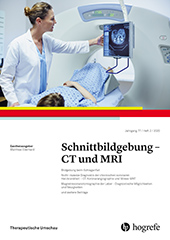Lungenrundherde – Ein Überblick
Abstract
Zusammenfassung. Die Computertomographie wird durch ihre schnelle Datenakquisition sowie ihre hohe räumliche Auflösung für vielseitige Fragestellungen eingesetzt. Häufig kommt es dabei zu Zufallsbefunden, wie beispielsweise Lungenrundherden. Die Ursache von Lungenrundherden ist vielfältig: vom harmlosen (postentzündlichen) Granulom, über Ausdruck einer interstitiellen Lungengerüsterkrankung, bis hin zu einem malignen Geschehen. Dies bringt Radiologen und Zuweiser häufig in ein diagnostisches Dilemma: Sind Nachkontrollen oder weitere Abklärungen notwendig? In welchen Abständen soll nachkontrolliert werden? Zur Handhabung von Zufallsbefunden gibt es in der Literatur mehrere Leitlinien, allen voran die «Guidelines der Fleischner Society». In dieser Übersichtsarbeit soll auf die Bildgebung und aktuelle Richtlinien für die weitere Abklärung eingegangen werden. Zudem gibt der Artikel einen kurzen Ausblick zum Lungen-Tumorscreening.
Abstract. Computed tomography (CT) offers fast temporal and high spatial resolution and is increasingly employed for various investigations. Since the 1990s, when multislice computed tomography (CT) technique became commonly available, the detection rate of incidentally detected pulmonary nodules has increased. The aetiology of pulmonary nodules can range from infectious over interstitial lung disease to malignant entities and pose a diagnostic dilemma: Should the incidental finding be dismissed or further investigated? If further investigated which modality and which time frame should be used? Due to the multidisciplinary nature of data required for the complex assessment of an incidental pulmonary nodule, management guidelines are needed in the diagnostic process such as those proposed by the Fleischner Society. The aim of this review is to discuss the different aetiologies pf pulmonary nodules and their potential work-up. Finally, we will also discuss the utility of lung cancer screening.



